- Details
- Written by: Wilko Jonker
- Hits: 3172
1962
Soon after the introduction of the Lockheed Starfighter within the Royal Netherlands Air Force, the type was flown during a parent day at air base Eindhoven.
1963
This year the Dutch Air Force celebrated its 50th birthday on July 1 during the Open Day at Soesterberg air base. The Lockheed Starfighter was then flown on a large scale, namely no less than twelve aircraft in three formations of each four aircraft.
1964 - 1973
During this period, the Starfighter was also demonstrated during Open Days of the Dutch Air Force.
During the Open Day at air base Leeuwarden on July 1, 1968, the demonstration was performed by Glenn 'Snake' Reaves. His Starfighter was equipped with tip tanks that had been sprayed in overall orange day glo. Under the fuselage two dummy Sidewinders were taken, which were also overall orange day glo.
Later that year, on the occasion of the 25th anniversary of 322 squadron on September 14, 1968, a display was flown with a Starfighter by captain De Ridder.
In addition to solo performances, four-tier formation displays were also flown.
1974 - 1979: Hans van der Werf.
Early 1974, the Dutch Air Force received a request from England to participate in the so-called "Battle of Britain Days".
Now air base Volkel was assigned to take care of a display with the Starfighter. Until that time, it was always done by the squadrons of the Leeuwarden air base.
The choice for the display pilot soon fell on lt. Hans van der Werf.
Together with an experienced test pilot and the air safety officer, the program was studied and discussed. After a short period of about two weeks, Van der Werf flew his first show over RAF base Finningley on September 21, 1974.
This show made very much impression, especially because the Starfighter did not have such a good name.
The first show in the Netherlands was on 19 June 1975 because of the presentation of the prototype of the F-16 in the Netherlands. In August 1975, the first major performance during the Open Day was at Volkel air base.
In the years after, Van der Werf performed many shows at home and abroad.
In 1978, the Dutch Air Force was 65 years old and Van der Werf received a specially painted machine, D-8091. This was fitted with a red-white-blue tail. The first performance with this aircraft was on June 17, 1978 during the Open Day at airb base Deelen.
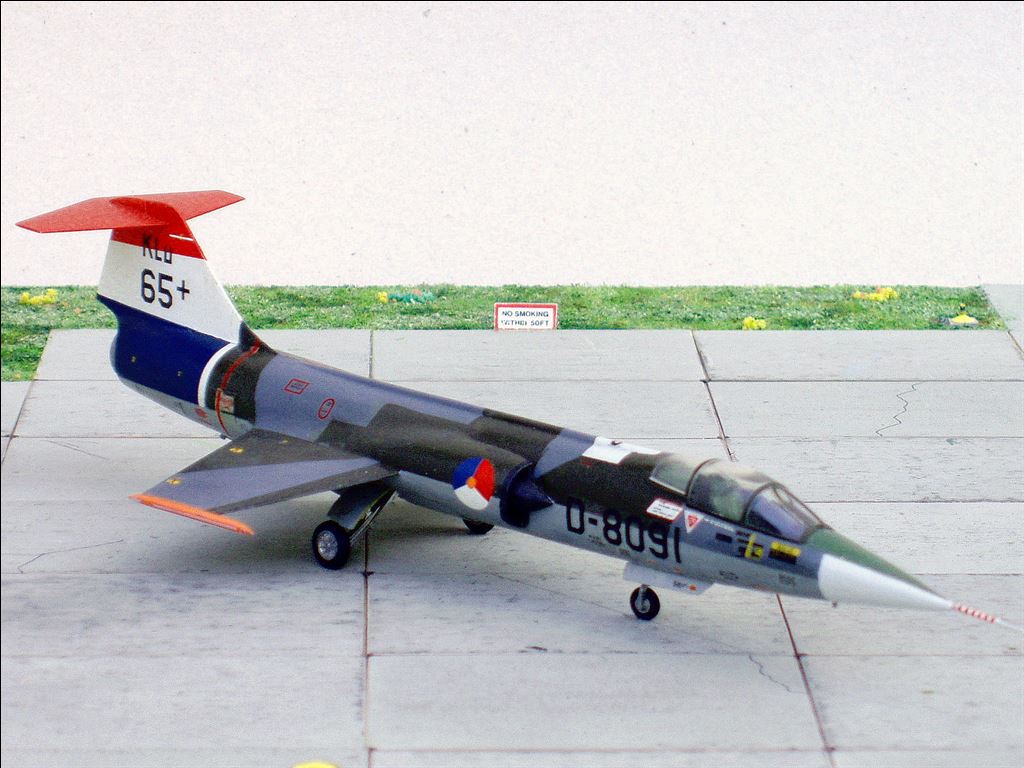
1/72nd Scale
Decals
- Dutch Decal
- Set 72006: Decalset for F-16 and F-104G; contains decals for F-104G: D-6680 (OCU); D-8022: three colour camouflage; D8091 and D-8343: overall grey; D-8331: farewell scheme display pilot H v.d. Werff; D-8300: with grey tail of D-6666; D-8091: KLu 65; RF-104G: D-8065: with ECM; TF-104G: D-5806: grey. [Stencilling for two aircraft].
1979 was Hans van der Werf's last year to fly with the Starfighter. This year he also had a specially painted aircraft, the D-8331. This was fitted with a red-white-blue rudder and a shark mouth.
When Hans van der Werf left the Royal Netherlands Air Force in October 1979, he received a satisfaction statement from the Commander of the (Dutch) Air Forces for "representing the KLu in a very good and worthy manner, by the F 1975 in 1979 with the F -104G, to provide pre-flight demonstrations at international and national fly shows. These demonstrations showed very high professionalism and were carried out with great personal dedication and devotion. "
The years after that, the Starfighter was still flown at shows, but because the type was to be phased out and replaced by the F-16 in the early 80's, these displays were slowly reduced and so came an end to an era.
- Details
- Written by: Wilko Jonker
- Hits: 2266
In 2002 in the run-up to the Open Days of the Royal Netherlands Air Force at air base Gilze-RIjen, the plan was to come up with an AH-64D Apache Solo Display Team.
After permission from the RNlAf Head Quarters at The Hague, contact with experts from the Boeing factories was then sought to find out the possibilities of the Apache.
In conjunction with Boeing, a flight program was compiled in a relatively short period.
Some spectacular parts of the display were:
- Hammerhead: Climbing until the speed drops and with a vertical roll diving back to the starting point
- Jaques Flop: Hovering and rotate the longitudinal axis and then turn 180 degrees
- Looping: This is very complex for a helicopter and strongly dependent on the wind
- Flare-dropping: Flying maybe not so special but yet an attractive part of the show, with the helicopter launching some flares (meant as defence against enemy missiles) while flying short turns.
Also in 2003, a solo display was flown with the Apache, although the programme was slightly different from 2002 show. For both years, both display pilots were Wandert Brandsen and Hein Faber.
Often the team composition changed, but in terms of composition they were equal, one or two Team Coaches (experienced Apache pilots), one team captain (= display pilot in command), a display pilot and four aircraft specialists from the support staff of the 301 squadron.
In 2005, the team was transferred to the operational squadron and captain Raymond Laporte was added to the team as a new copilot. That same year, the team won the 'Sir Douglas Bader Trophy' for the best solo display during the Royal International Air Tattoo.
Due to posting in Iraq and Afghanistan, after 2006, no solo display was flown with the Apache.
In 2010 when the postings ended, a team could be assembled again. Major Laporte, Test Pilot, began to practice with Major Roland Wally Blankenspoor and performed shows in Belgium, the Netherlands and also during the International Air Tattoo. For the shows the same aircraft, the Q-19 was used, which flew with a custom colour scheme that was applied as stickers.
In 2011, Laporte left the team and Captain Paul 'Wokkel' Webbink became the new copilot. Blankenspoor became the new display pilot. Because the flying movements flown during the show are non-standard, the experience of the pilots with the type is a very important requirement.
Also now one special aircraft was assigned to the team, the Q-17. This was provided with an attractive colour scheme, also now applied in the form of stickers.
Also for 2013, this aircraft was used, fitted with a customized colour scheme because of the centenary of the Royal Netherlands Air Force.
- Details
- Written by: Wilko Jonker
- Hits: 4732
Red Noses aerobatic team 1956.
During 1956 captain C.A.M. Poublon, squadron 314 raised a Thunderjet-team. Soon the Thunderjets were replaced with the Republic Thunderstreak. Other members were lieutenant Hans de Jong; lieutenant . R. De Koning and ensign Hans (Red) Verdonk.
Poublon had already joined a Thunderjet-team during 1952/1953. This team flew a display July 18, 1953 at Soesterberg, because of the 40th anniversary of the Royal Netherlands Air Force. This show was of such good quality, that it stated that it could be compared with the famous USAFE-Thunderjet-team ‘The Sky Blazers’.
Training for the show of the Red Noses was done besides the usual training program of the pilots.
The show contained parts like: take-off in box formations, than a echelon-right formation an a right turn and a roll in box formation. The show ended with a spectacular downward bomb burst!
In 1957 the team joined the national championship formation flight of the Royal Netherlands Air Force. The team ended up as last. In august, 1957 a final show was flown at the "Gouden ILSY" (ILSY = Internationale Luchtvaart Show Ypenburg = International Air Show Ypenburg).
The memorials of squadron 314 mention an attempt to adjust smoke generators. Chief Armament P. Koning developed these from two rockets. These were attached and secured with steel-wire. the smoke of the propulsion of these rockets would take care for the smoke trails. The first tests were unsuccessful. Both rockets got loose and disappeared.
No further information is known about this display team.
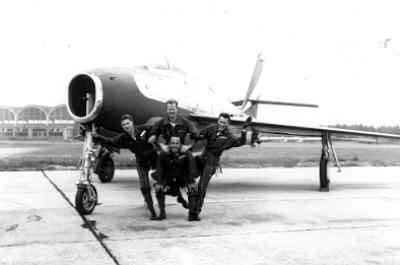
[Enclosed photo from BeeldBank NIMH. Click on photo for ordering information]
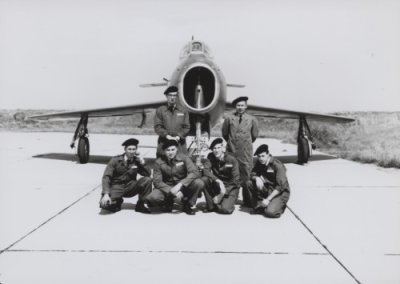
Standing from left to right Erkelens, Van de Leur. Kneeled from left to right Ulderink, Ulderink, De Groot and Vogler.
[Enclosed photo from BeeldBank NIMH. Click on photo for ordering information]
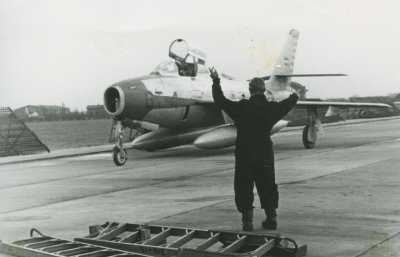
[Enclosed photo from BeeldBank NIMH. Click on photo for ordering information]
Colour scheme
The first years the Dutch Thunderstreaks were 'bare metal". Soon problems with corrosion occurred, so halfway the fifties the undersides of the aircraft were sprayed with aluminium varnish. The aircraft of the Red Noses team were probably original bare metal.
On all Dutch F-84F's the standard ‘NATO’ aircraft stencilling was applied.
| Colour | KLu-name & code | FS-number | BS-number | Humbrol | XtraColor |
|---|---|---|---|---|---|
| Aluminium | Aluminium | 17178 | 11 / 191 | 216 / 252 / 501 | |
| Red | Rood | 21136 | 538 | 153 | 103 |
Check www.paint4models.com for an extensive conversion table with lots of colour and paint systems.
The aircraft of the Red Noses team were provided with a special colour scheme. Probably applied because of the Championship or because of the ILSY. I managed to find just very few photo's, all seem to be the result of one photo session, because both technical crew and the team members are posing in front of one of the aircraft.
The tail was probable painted in red, white and blue. The nose was red, flushing towards the wings. The leading edge was also painted red with a small white frame.
The drawing shows how the aircraft might have looked like.
Further information about this display team would be appreciated.
Click here for information about the Dutch Thunderstreaks in general click here.
Literature and resources.
| Avia; nr 9, jaargang 32, 09-1973 | P.324 - 325 | 1973 | Uitg. Wyt Rotterdam | |
| Avia; nr 5, jaargang 34, 05-1975 | p.162 – 163 | 1975 | Uitg. Wyt Rotterdam | |
| Modelbouw in Plastic, nr. 3, jaargang 17, 1976 | Pag. 6 – 11 | 1976 | Uitgave: IPMS Nederland | |
| AviaHobby | P. Gols & H. Loeber | Pag. 161 – 170 | 09-1980 | Uitg. Wyt - Rotterdam |
| F-84 in action, Aircraft-number 1061 | L.Davis & D.Menard | Uitgave: Squadron Signal | 1983 | |
| Vliegend in Nederland deel 1: Thunderstreak | G.A. Hilterman | 1986 | Uitgave: Flash Aviation-Eindhoven | |
| display teams van de Koninklijke Luchtmacht | A. Louwers | Pag.11-16; 20-23. | 1988 | Uitgave: De Alk - Alkmaar |
| Modelbouw in Plastic,nr. 2, jaargang 17; 1988 | F. Bachhoffner e.a. | Pag. 34 + 35 | 1988 | Uitgave: IPMS Nederland |
| 40 JAAR 314 SQUADRON 1952 - 1992 “Zie ze vliegen deel III” | Elt. “M.A.F. Spinks“ | p.33 en p.36 | 1992 | Uitgave KLu Bureau Druk-realisatie |
| Modelbouw in Plastic, nr.1 Jaargang 22, 1993. | F.Bachoffner | P.2 – 7 | 1993 | Uitgave: IPMS Nederland |
| Modelbouw in Plastic, nr. 4, jaargang 23; 1994 | K.W.Jonker | Pag. 74 – 84 | 1994 | Uitgave: IPMS Nederland |
| Squadrons van de Koninklijke Luchtmacht (Derde druk) | W.F. Helffrich | pag. 30, 33, 34, 129 t/m 169 | 1994 | Uitg. W.F. Helffrich – Hilversum |
| Luchtvaartwereld; nr. 1, jaargang 1; 1999 | Peter de Jong | Pag. 45 – 49 | 1999 | Uitg. Geromy - Maarssen. |
| Luchtvaartwereld; nr. 2, jaargang 1; 1999 | Pag. 41 – 45 | 1999 | Uitg. Geromy - Maarssen. | |
| Luchtvaartwereld; nr. 3, jaargang 1; 1999 | Pag. 53 – 55 | 1999 | Uitg. Geromy - Maarssen. | |
| Luchtvaartwereld; nr. 4, jaargang 1; 1999 | Pag. 51-52 | 1999 | Uitg. Geromy - Maarssen. | |
| Camouflage en Kentekens | J.H.N Greuter e.a. | Pag. 57 – 61; 69 – 74; 99 – 105 | 1998 | Uitg Bonneville |
Special thanks to: L. Boerman (Dutch Decal); Hr. Ulderink (photo’s and information); Sectie Militaire Luchtvaart Historie (foto’s en Info)
- Details
- Written by: Wilko Jonker
- Hits: 5763
During the Open Day 1970 at Volkel Air Base is the first demonstration of the Fokker F.27 was flown.
The following years the F.27 was a regular guest of the open days of the Air Force, in all cases was the Major B. Soons the pilot`.
Display 1973: Fokker F.27 300M C-7`
In 1973 it was flown with a completely white aircraft, the C-7. This was used at that time for United Nations missions.
Display 1979: Fokker F.27 300M C-10
In 1979, the Fokker F.27 for the first time joined the International Air Tattoo Greenham Common. The crew consisted of the Major B. Soons, the Major J. Jütten, adjutant Den Belder, Sergeant I Van Beek and Sergeant I Roos. The team succeeded to win the International Display Sword.
A novelty was that the use of smoke to make the display more attractive. The technical service of 334 Squadron had made a construction with a diesel tank, pump and nozzle fitted to diesel was sprayed in the hot exhaust.
Display 1981: Fokker F.27 300M.
In 1981, the team this time with Major B. Soons, Major J. Jütten and Sergeant I Van Beek once again won the International Display Sword (for non-UK participants) at the International Air Tattoo.
Major Soons left the display team on September 12, 1981.
Display 1982 - 1983: Fokker F.27 300M C-10 and C-8
In 1982, not only a new team was formed, now consisting of the Major J. Jutten, Captain J. Reffeltrath, Sergeant I Van Beek and R. Nahon and as a coach and spare J. van den Broek. Also the program was renewed and expanded to a seven-minute show. The show was carried out with the C-8, or with the C-10.
The pilots Reffeltrath and Jütten alternated the shows.
In 1983 the team won again a prize at the international Air Tattooo and won an honorable third prize in category Best Flying Demonstration by an Overseas Participant.
Display 1984: Fokker F.27 300M.
In 1983, Major J Jütten left the team and was succeeded in 1984 by Captain P. Schneider as co-pilot.
The show was again renewed, and especially the last part of the show was spectacular with a low pass, followed by a steep climb immediately followed by a roll with maximum slope, giving the impression of a looping.
In 1984 there was a slight problem when, during at the end of the display in Copenhagen, a long flame started behind the right engine. Fortunately, this incident ended well.
A nice video film: Display 1984 Gardermoen, Norway
Display 1985: Fokker F.27 300M C-6.
In 1985 the team was invited to participate in the 25th anniversary of the Italian Frecce Tricolore. The show was also flown in front of the Italian president.
Display 1986: Fokker F.27 300M.
For 1986 Captain P. Schneider became the leader of the team with the second pilot B. van Asselt, flight engineer sergeant-Major J. Bisschop and second lieutenant M. Spit, for the PR and coaching.
Display 1987: Fokker F.27 300M.
In 1987 P.Schneider unexpectedly departed and J. Reffeltrath was again asked to lead the F-127 display. He formed a team with as co pilots B. van Asselt and second lieutenant J. Maasdam (who alternated) and further R. Nahon, J. Bisschop and M. Spit. This season was awarded a satisfaction vindication of Major General Vendrig.
Display 1988: Fokker F.27 300M C-5.
In 1988 B. van Asselt was now transferred to 336 squadron and had left the team, which appeared with a specially painted Fokker to mark the 75th anniversary of the Royal Netherlands Air Force.
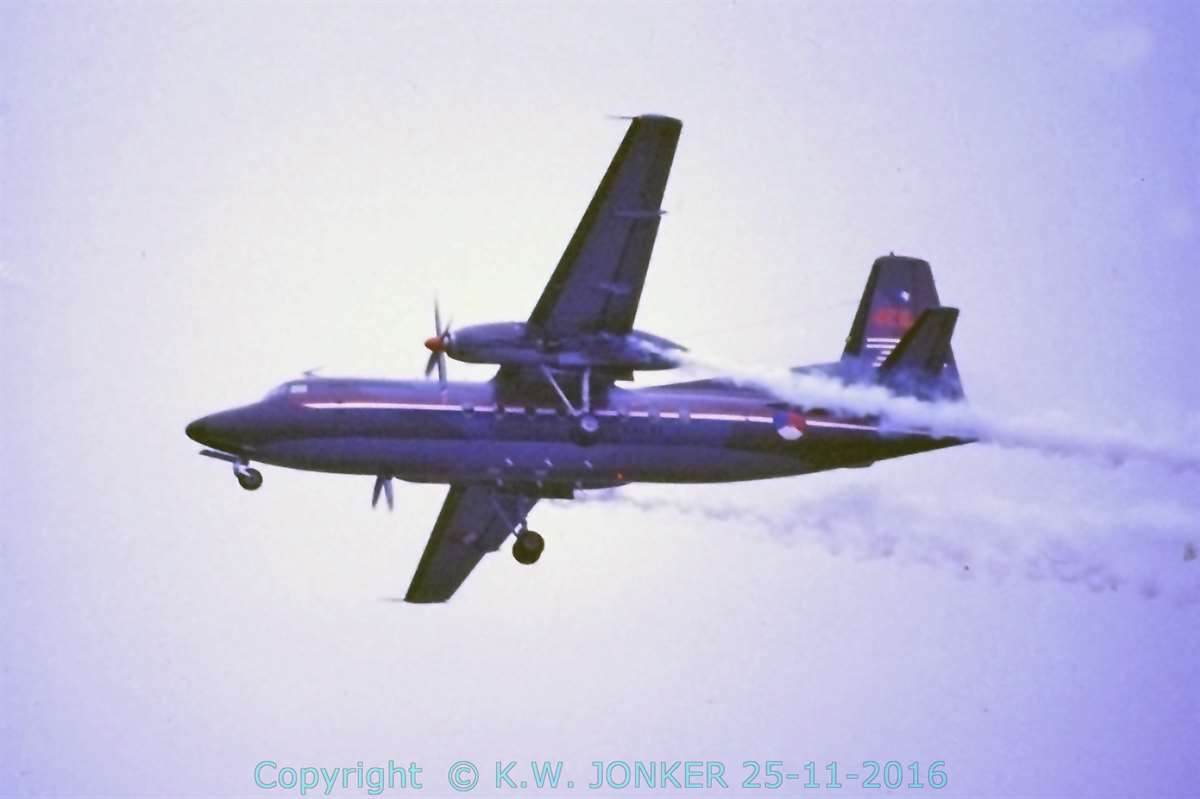
Fokker F.27 Troopship C-5 with display marking s KLu 75 at airshow Lelystad,July 1988 at airfield Lelystad.
In May 1988 following show was flown in France:
Below the show flown in June 1988 at air base Deelen because of the 75th anniversary of the RNlAF.
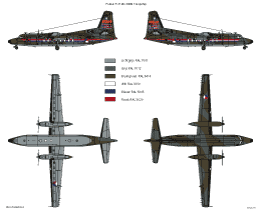

Display 1992 and 1993: Fokker F.27 300M C-10.
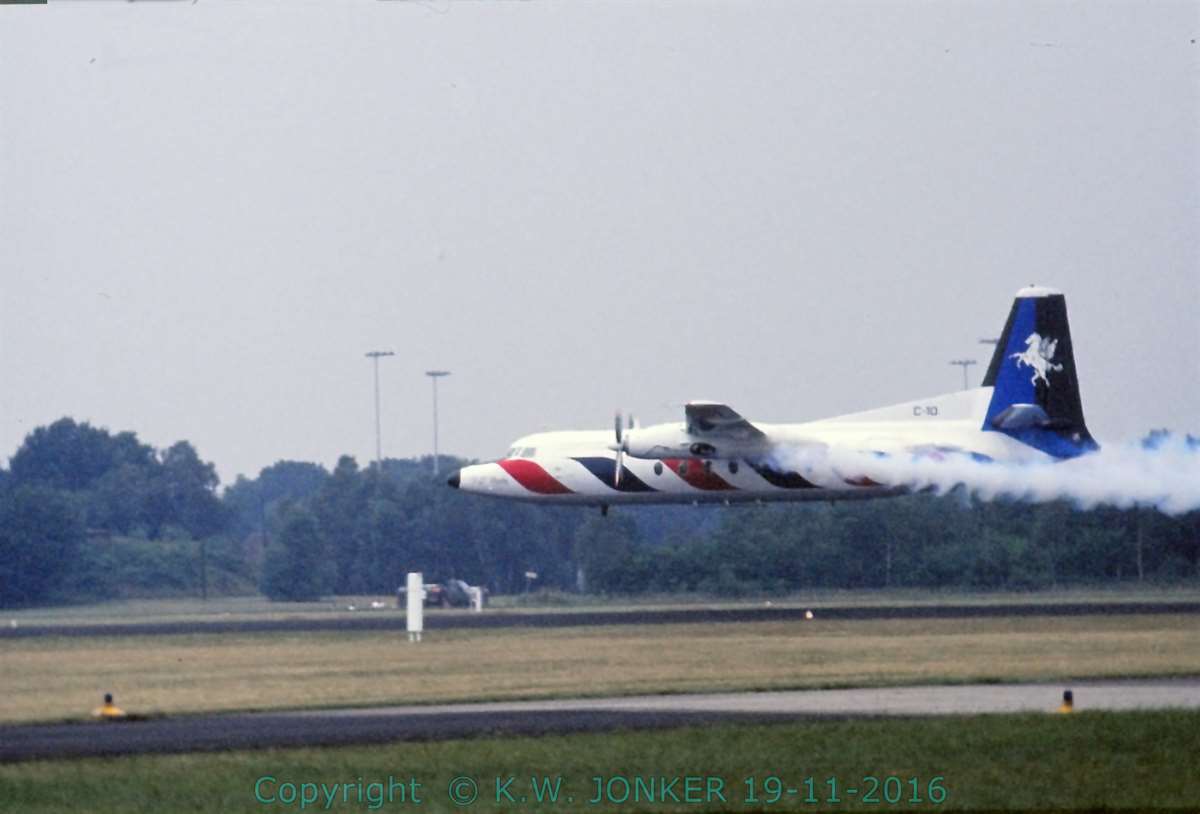
Fokker F.27 Troopship C-10 with display markings at the Open Day Dutch Air Force, June 1992 at airbase Gilze-Rijen.
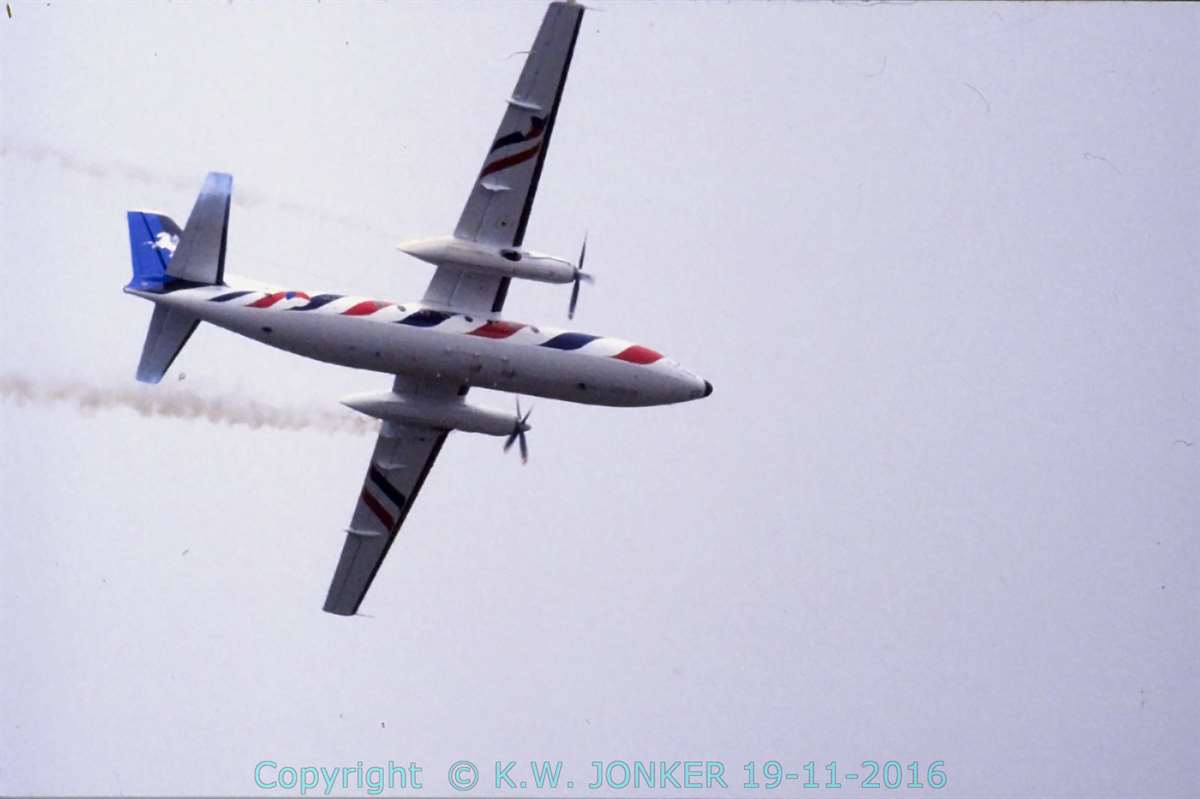
Fokker F.27 Troopship C-10 with display markings at the Open Day Dutch Air Force, June 1992 at air base Gilze-Rijen.
A nice video film: Display 1984 Gardermoen, Norway
Display 1994 - 1995: Fokker F.27 300M C-8.

Fokker F.27 Troopship C-8 with display markings at the Open Day Dutch Air Force, July 1995 at air base Volkel.
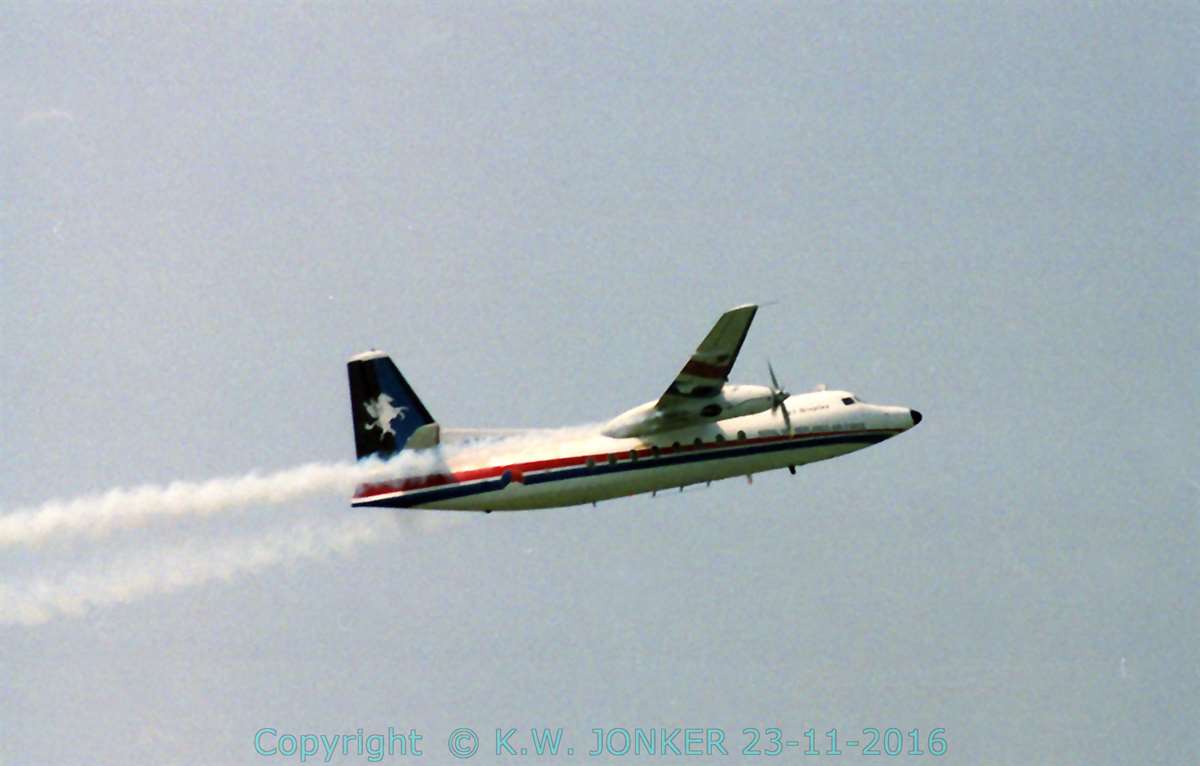
Fokker F.27 Troopship C-8 with display markings at the Open Day Dutch Air Force, July 1995 at air base Volkel.
Below a video shot of the display at RAF Leuchars Airshow in 1995. The show started wit a very low pass just after take off.
The F.27 display team existed in 1995 if aviator ELt Willem Wildvank and als co-pilot Jan Brekelmans
Fokker F.27s last display flown at Malta, 1995.
- Details
- Written by: K.W. Jonker
- Hits: 4548
“Ruiten Vier” 1952 -1955 (327 Sqn.)
Mid 1952 at squadron 327 a team started training display flying with the Gloster Meteor F.Mk.8.
The team, named "Ruiten Vier (= Diamonds Four) consisted of four men, with leader Major J. Wansink and further first lieutenant W. Heijen, Reserve second lieutenant H. Tiel and sergeant P. Jansen. Initially the training was unofficial, because prior to official permission, General Aler would see 'Ruiten Vier' perform their show first. Only then could be continued with provisional approval.
During an air show at Soesterberg in August 1952, Major J. Wansink presented his stunt team "Four Diamonds" for the first time. The aircraft had an special colour scheme applied
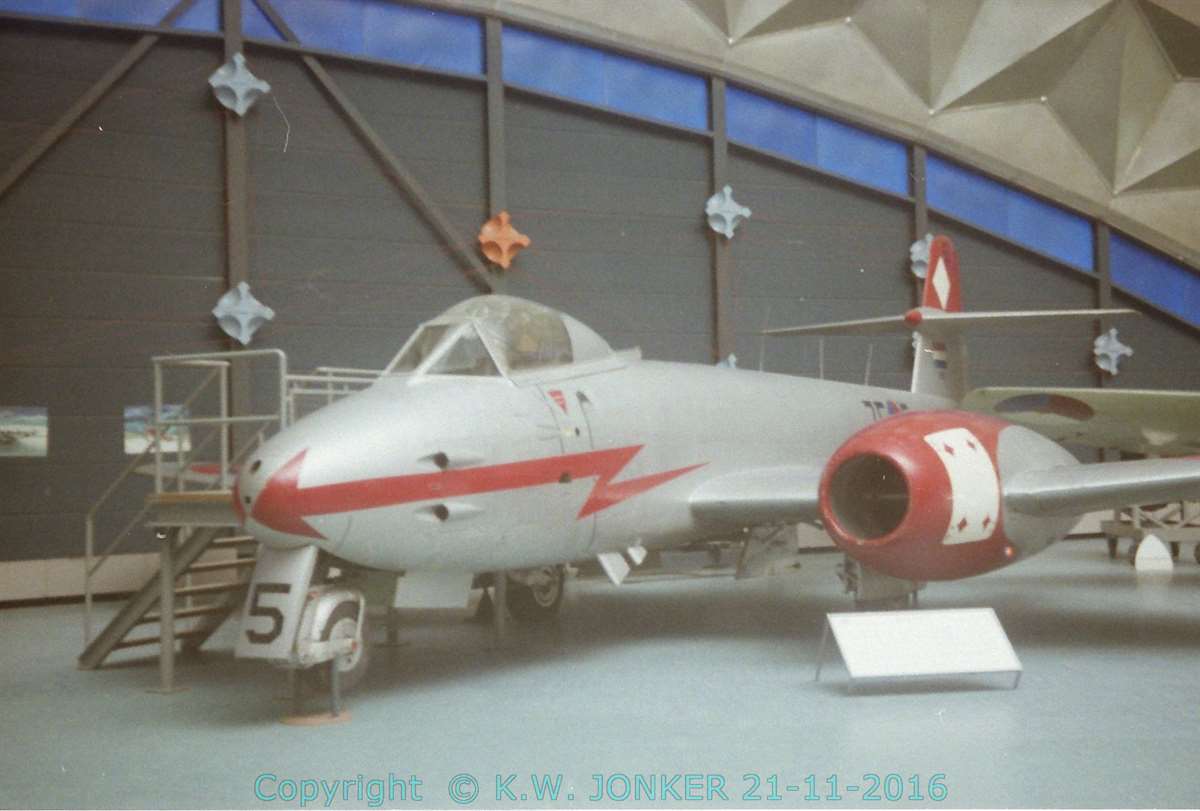
Gloster Meteor F.MK.8 with "Ruiten Vier"markings, photographed in 1979 in the former Aviodome at Schiphol.
In 1953 the Air Force became a separate part of the Dutch defence, named Royal Netherlands Air Force (Koninklijke Luchtmacht). It was also the year of the fortieth anniversary of the Dutch air force.
Because of the anniversary an special Air show was at air base Soesterberg with the National Competition Stunt Flying, with which several teams from England, Belgium, Danmark France and Italy and of course several Dutch teams participated.
Three Dutch teams went to the finals: “Ruiten Vier”, de “Aerobats” of the Dutch navy and the Harvard team of CLO.
The “Ruiten Vier” team with the Meteors became the winner of the trophy.
The team was disbanded in 1955 as Major Wansink and Lieutenant Heijnen both were transferred.
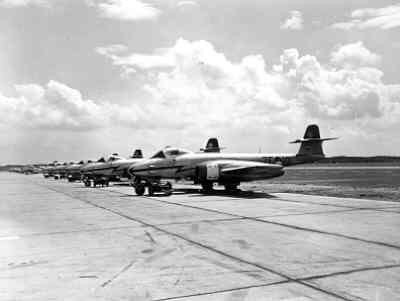
[Enclosed photo from BeeldBank NIMH. Click on photo for ordering information]

[Enclosed photo from BeeldBank NIMH. Click on photo for ordering information]

Winners of national stunting competition 1953.
From left to right Wansink, Tiel, Heynen, Jansen.
[Enclosed photo from BeeldBank NIMH. Click on photo for ordering information]
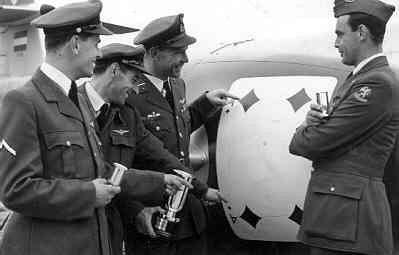
Winners of national stunting competition 1953.
From left to Jansen, Heynen, Wansink, Tiel.
[Enclosed photo from BeeldBank NIMH. Click on photo for ordering information]
Colour schemes.
The aircraft were overall aluminium dope, the standard paint scheme of the Meteor at that time. Further the nacelles had a red inlet tapering on both top and undersides to a point.
On the nose section a red thunderbolt was painted at both sides. The air intake had also a picture of the "Four Diamonds" game card applied.
Later, the paint scheme was extended and the upper part of the vertical stabilizer was painted red and there was a white diamond figure applied to the vertical tail. Also the ends of the horizontal stabilizer were at the upper and under sides painted red. .
The aircraft used, were Gloster Meteor F Mk8 with serials 7E-5, 7E-11, 7E-13, 7E-14 and as spare 7E-8
_AKleijn.jpg)
Literature.
| display teams van de Koninklijke Luchtmacht | A, Louwers | pag. 37 - 39 | 1988 | De Alk bv - Alkmaar |
Websites.
Special thanks to A. Kleijn for the original (Dutch) text of this article.

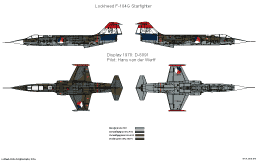


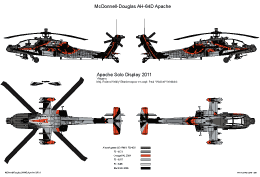
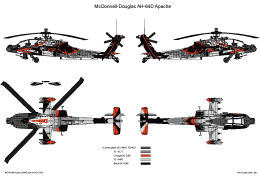

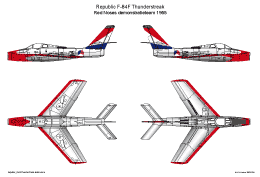
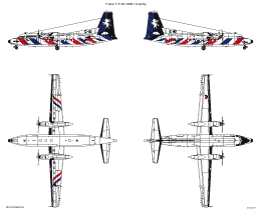
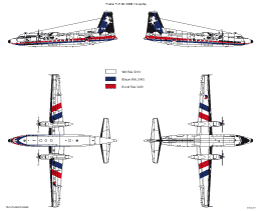
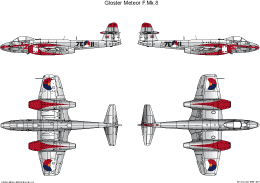
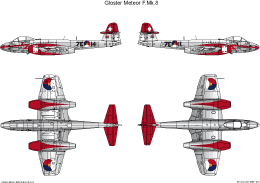
 Nederlands (nl-NL)
Nederlands (nl-NL)  English (United Kingdom)
English (United Kingdom)